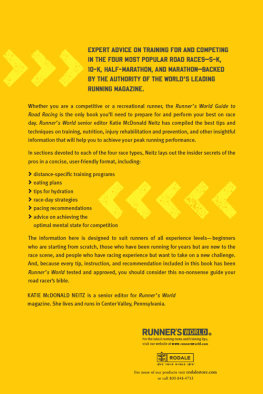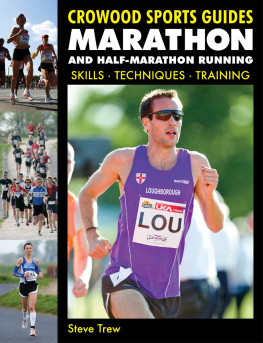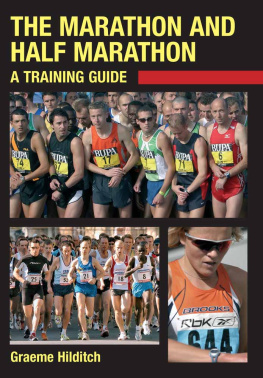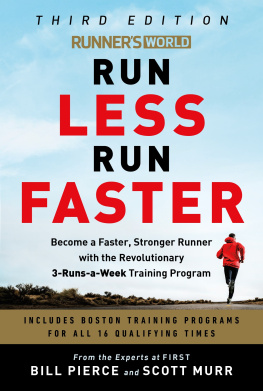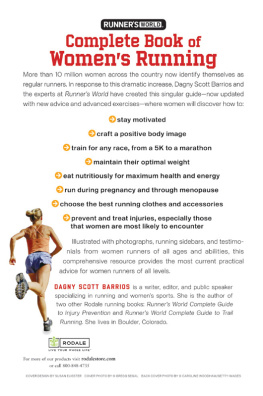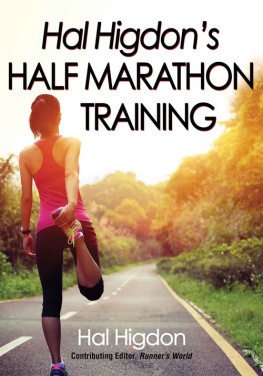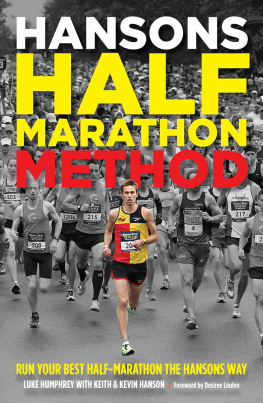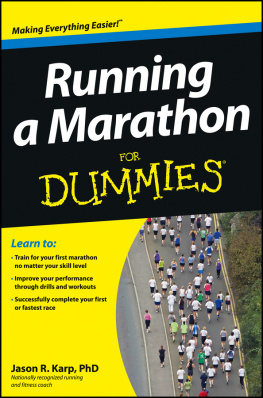To Amby Burfoot, David Willey, and all the
Runners World experts whose support and
knowledge have fueled my running and writing
INTRODUCTION
Before I begin this book, I should make a disclaimer. One of the participants of the 1996 Frozen Foot 5-K in Elizabethtown, Pennsylvania, was an out-of-shape, out-of-her-league 20-year-old dressed in layers of bulky sweats and a hefty pair of aerobics sneakers who spent more time than shed care to admit reaching the finish line. Anyone who witnessed the spectacle (my apologies) or has records of the event (the curse of the Internet) may question that persons ability to put together a book about the sport of road racing. Fair enough. But what that skeptic wouldnt realize is that although this womans first road race wasnt successful by most peoples standards, it was life changing, quite literally. You see, it made her just the type of person who is qualified to edit such a book.
I was in college when I decided on a whim to run the 5-K. Im not sure what made me think I could pull off running 3.1 miles without training, especially being someone with no running experience or real athletic background at all. Unlike most of my friends, I didnt run track or cross-country or play field hockey or soccer in high school. Step-aerobics classes and Buns of Steel videos were more my speed. Maybe my ill-founded confidence came from the fact that I originally thought the race was a 5-miler (Oh, if its only 3.1 miles ). Maybe it was the fact that several of the colleges most tenured professors were running it (If those geezers can do it ). Maybe it was the fact that it was held in January, after a Christmas-cookie-indulgent break (Running burns how many calories?). Whatever the reasonhowever naive, misguided, or silly it wasI was in.
But in for what, exactly?
I dont remember details about the start, or the scenery along the course, or at what point my starting-gun sprint faded to a jog, then to a shuffle, then to a walk. What I do remember is the finishspecifically, the finish line. When I saw it up ahead, a surge of adrenaline kicked in, giving my weakened legs and wounded psyche a much-needed boost of speed and confidence. And when I reached the end of my journey, a feeling of exhilaration (along with a hefty dose of relief) washed over me, erasing the pain and frustration I had felt minutes earlier. I felt incredibleunbelievable, really. Doubts I had about finishing were gone. More important, doubts I had about myself were gone. It was a very Rocky-like moment, in more ways than one. See, the exercise-induced feel-good chemicals buzzing around in my brain were already negotiating for a sequel. My muscles were too exhausted to put up a fight.
And so, a month later, I ran another 5-K, then another one the month after that. I had started a modest training program and set reasonable goals for myself. I ran/walked the February race, and by March, I was able to run the entire distance. Yay! I felt strong, I felt empowered, andfor the first time in my lifeI felt athletic. And that felt good.
I started reading Runners World and continued to run in 5-Ks through my college years. I wasnt fast, but I was committed. Running became part of my life, an important daily ritual that helped me find balance and blow off steam in between school, internships, and a little thing called trying-to-figure-out-what-to-do-with-my-life.
When youre in journalism school, youre told to write about what you know or, better yet, what you feel passionate about. And so I decided that one day I should write for Runners World. It took me a few years, but I did eventually land my dream job. Runners World is an ideal place to work, and not just because running shoes are acceptable office attire and you dont have to look far for an eager running buddy. Ill admit those are great perks. But thats not what really makes Runners World so special.
Runners World has been a leading authority on the sport since 1966providing runners of all backgrounds and abilities valuable information on training, nutrition, and racing. The experts who contribute to the magazine are some of the most talented and skilled coaches, athletes, physical therapists, sports medicine physicians, nutritionists, sports psychologists, and gear gurus in the world. Everything you need to know to run and race your best is always an issueor, in my case, a cubicleaway. Runners World is also a nurturing, supportive source of inspiration and encouragement. It shows runners that success comes in many formsthat simply making it to the finish line is a victory worth celebrating.
Im often asked if racing is a job requirement at Runners World. Its not, of course, and time trials arent part of the interview process, by the way. But most Runners World staffers drink the water, so to speak, and end up spending much of their free time either participating in road races or preparing for them. I think its the same effect of reading the magazine: You get inspired by the stories told. You get excited about the sport. And you get motivated to get out there and toe the line for yourself.
Thats what happened to me. Thanks to my experience with Runners World, first as a reader and now as an editor, Ive enjoyed many races, from 5-Ks to marathons. And Ive learned a lot of things along the wayincluding the value of a nonchafing sports bra, lightweight running shoes, and hill training (my new Buns of Steel workout).
My goal for this book is to share the wisdom and support that Ive been so lucky to receive. I went straight to the sourceRunners Worldand compiled the best information the magazine has to offer on preparing for a road race. The training plans, nutritional advice, and injury-prevention strategies laid out here will help you run your best race whatever the distance (5-K, 10-K, half-marathon, marathon) or whatever your goal (to run a personal record or simply to finish). The information here is designed to suit runners of all experience levelsbeginners starting from scratch, those whove been running for years but are new to the race scene, and people who have racing experience but want to take on a new challenge.
I assure you, youre in good hands. Every tip, every instruction, every recommendation included in this book has been Runners World tested and approved. Hows that for a head start?
Katie McDonald Neitz
People become runners for all sorts of reasons. You might have taken up the sport because you wanted to lose weight, lower your blood pressure, or reduce stress. Smart move. Scores of research studies have shown that a regular program not only improves your physical health by reducing your risk of heart disease, diabetes, and cancer, but it also enhances your mental well-being, boosting mood, lowering anxiety and depression, and even preventing dementia and Alzheimers disease. These health benefits are wonderful, and we runners are certainly appreciative of them, especially as we get older. But when youre struggling to wake up for a morning run, reducing your cholesterol a few points may not be motivation enough to get you out of bed. A more immediate goal or rewarda 5-K a few weeks away, for examplemay be the incentive you need to fight the urge to sleep in. And because more racing means more running, participating in races increases the odds that youll fulfill all the goals that got you running in the first place.

